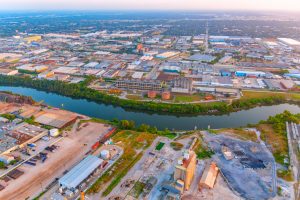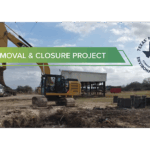 Environmental remediation is a crucial process aimed at restoring and cleaning up contaminated sites in Brownsville. With growing concerns about the environment and the impact of pollution, the role of remediation companies has become increasingly important in creating a sustainable future. This article dives into the world of environmental remediation, highlighting its significance, key processes, the role of remediation companies in Brownsville, selecting the right company, and future trends in the field.
Environmental remediation is a crucial process aimed at restoring and cleaning up contaminated sites in Brownsville. With growing concerns about the environment and the impact of pollution, the role of remediation companies has become increasingly important in creating a sustainable future. This article dives into the world of environmental remediation, highlighting its significance, key processes, the role of remediation companies in Brownsville, selecting the right company, and future trends in the field.
Understanding Environmental Remediation
Environmental remediation is the systematic approach to mitigate, remove, and prevent contamination in soil, water, and air. It encompasses a wide range of techniques and processes that aim to restore the affected environment to its natural state. Whether it’s industrial waste, chemical spills, or soil pollution, environmental remediation plays a critical role in protecting human health and preserving the ecosystem.
The Importance of Environmental Remediation
Environmental remediation is vital for various reasons. Firstly, it helps to safeguard public health by eliminating or minimizing exposure to hazardous substances. Contaminated sites can pose a significant risk to nearby communities, and effective remediation ensures the safety and well-being of residents.
Imagine a scenario where a chemical spill has occurred near a residential area. The spill has seeped into the soil and contaminated the groundwater, posing a potential threat to the local drinking water supply. Environmental remediation would involve the careful excavation of the contaminated soil, followed by the implementation of in-situ treatment techniques to remove the remaining pollutants. This comprehensive approach ensures that the community’s access to clean and safe drinking water is restored.
Secondly, environmental remediation promotes environmental sustainability by restoring ecosystems and protecting biodiversity. Contaminated environments can have devastating effects on plant and animal life, disrupting delicate ecological balances. Through the use of bioremediation techniques, for example, naturally occurring microorganisms are harnessed to break down pollutants and restore the ecological health of the affected area.
Consider a case where an oil spill has occurred in a sensitive coastal ecosystem, threatening the survival of various marine species. Environmental remediation efforts would involve the deployment of specialized equipment to contain and recover the spilled oil. Additionally, techniques such as soil vapor extraction may be employed to remove any residual contaminants from the affected soil. These measures not only help to protect the immediate environment but also contribute to the long-term preservation of biodiversity.
Finally, environmental remediation is often a legal requirement to comply with environmental regulations and ensures responsible and ethical practices. Governments and regulatory bodies impose strict guidelines to ensure that contaminated sites are properly addressed and restored. By adhering to these regulations, industries and organizations demonstrate their commitment to environmental stewardship and sustainable development.
Key Processes in Environmental Remediation
Several processes are employed during environmental remediation to address different types and levels of contamination effectively. These processes may include excavation, in-situ treatment, bioremediation, soil vapor extraction, and groundwater treatment. Each technique is tailored to the specific requirements of the site and contamination, ensuring the best possible outcome.
Excavation is a commonly used technique in environmental remediation, particularly for removing contaminated soil or sediment. It involves the careful removal and disposal of the affected material, followed by the replacement with clean fill. This process is often used when the contamination is localized and can be physically removed without causing further damage to the surrounding environment.
In-situ treatment, on the other hand, involves treating the contamination without physically removing it from the site. This technique is often used when excavation is not feasible or when the contamination has spread extensively. In-situ treatment methods may include the injection of chemical agents or the use of specialized equipment to stimulate natural processes that break down the pollutants.
Bioremediation is a fascinating process that utilizes the power of microorganisms to degrade or transform contaminants into less harmful substances. These microorganisms, such as bacteria and fungi, have the natural ability to break down organic compounds found in various contaminants. By creating favorable conditions for their growth, such as providing nutrients and oxygen, bioremediation can effectively clean up contaminated sites and restore ecological balance.
Soil vapor extraction and groundwater treatment are techniques commonly used to address contamination that has migrated into the subsurface. Soil vapor extraction involves the extraction of volatile contaminants from the soil by applying a vacuum, while groundwater treatment focuses on removing contaminants from the water table. These processes often work in conjunction with other remediation techniques to ensure comprehensive cleanup.
Overall, environmental remediation is a complex and multifaceted field that requires a thorough understanding of contamination sources, site characteristics, and the most suitable remediation techniques. By employing these techniques and processes, environmental remediation professionals strive to protect human health, preserve ecosystems, and ensure a sustainable future for generations to come.
The Role of Remediation Companies in Brownsville
Brownsville is fortunate to have a dedicated network of environmental remediation companies that play a vital role in addressing the contamination issues in the region. These companies bring expertise, experience, and resources to effectively remediate the contaminated sites and contribute to the overall well-being of the community.
Services Offered by Remediation Companies
Remediation companies in Brownsville offer a comprehensive range of services to meet the diverse needs of their clients. These services include site assessment, contaminant identification, risk assessment, remediation planning and implementation, environmental monitoring, and regulatory compliance. By providing these services, remediation companies ensure that contamination is properly addressed and that the affected environment is restored to a safe and healthy state.
The Impact of Remediation Companies on Brownsville’s Environment
The presence of remediation companies in Brownsville has a significant positive impact on the environment. By effectively and efficiently remedying contaminated sites, these companies contribute to the preservation of local ecosystems and the protection of natural resources. Moreover, the successful completion of remediation projects enhances the overall quality of life for residents by eliminating potential health risks and creating a cleaner and safer environment.
Selecting the Right Environmental Remediation Company
Choosing the right environmental remediation company is a critical decision that should not be taken lightly. Several factors need to be considered to ensure that the selected company meets the specific needs of the project and achieves the desired outcomes.
Factors to Consider When Choosing a Remediation Company
When selecting a remediation company in Brownsville, factors such as experience, expertise, track record, certifications, and partnerships should be carefully assessed. An experienced company with a proven track record demonstrates its ability to handle complex remediation projects efficiently. Certifications and partnerships with relevant organizations can also indicate the company’s commitment to industry best practices and adherence to strict standards.
Questions to Ask Potential Remediation Companies
Before making a final decision, it’s essential to ask potential remediation companies some key questions. These questions may include inquiring about their specific experience with similar projects, the techniques and technologies they employ, the timeline for completion, and strategies for minimizing disruption to surrounding areas. Additionally, inquiring about the company’s commitment to sustainability and their approach to community engagement can provide valuable insights.
Future Trends in Environmental Remediation
The field of environmental remediation is continuously evolving, driven by advancements in technology and a growing commitment to sustainability. These trends are shaping the future of environmental remediation, both in Brownsville and globally.
Technological Advancements in Remediation
New technologies are revolutionizing the way environmental remediation is conducted. Innovations such as thermal desorption, nanoremediation, and electrokinetic remediation offer faster and more efficient ways to remove contaminants from soil and water. The development of remote sensing and imaging technologies also enables more accurate site characterization, improving decision-making during the remediation process.
The Future of Remediation in Brownsville
In Brownsville, the future of environmental remediation looks promising. With a strong commitment to environmental stewardship, the city continues to invest in sustainable practices and the remediation of contaminated sites. As technology advances and awareness grows, Brownsville is poised to become a model for effective and innovative environmental remediation practices, setting an example for other communities faced with similar challenges.
In conclusion, environmental remediation plays a critical role in addressing contamination issues and restoring the environment to its natural state. In Brownsville, environmental remediation companies have a significant impact on the well-being of the community and the preservation of the ecosystem. By offering comprehensive services, selecting the right company, and embracing future trends, Brownsville can continue to make great strides in environmental sustainability and create a healthier and cleaner environment for generations to come.
If you’re inspired by Brownsville’s commitment to environmental sustainability and are in need of expert environmental remediation services, look no further than ESE Partners. As leaders in environmental problem-solving, we’re dedicated to responsibly moving your business forward with our comprehensive suite of services. Whether it’s water compliance, due diligence, or remediation, our team of skilled environmental engineers and scientists is equipped to support you. With significant changes in the USACE review process for DA permit applications in the Galveston County District, it’s more important than ever to have a knowledgeable partner by your side. Don’t let regulatory complexities slow you down. Request A Proposal today and take the first step towards a cleaner, more sustainable future with ESE Partners.








